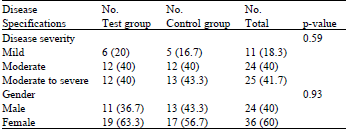Short Communication
Efficacy of Vitamin E to Prevent Dermal Complications of Isotretinoin
Department of Dermatology, Tabriz University of Medical Sciences, Tabriz, Iran
Hamideh Azimi
Department of Dermatology, Tabriz University of Medical Sciences, Tabriz, Iran
Mohamad Goldust
Student Research Committee, Tabriz University of Medical Sciences, Tabriz, Iran









